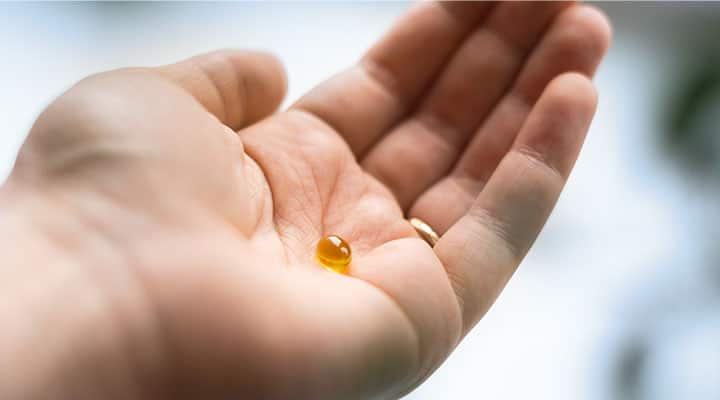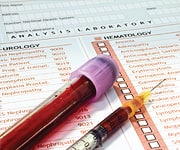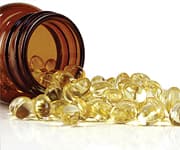Life Extension Magazine®

Human studies show that higher levels of vitamin D protect against cancer and other age-related ailments.1-9 This has made vitamin D an enormously popular supplement.
A "gold standard" double-blind, controlled study published in the American Journal of Clinical Nutrition found that women given supplemental vitamin D and calcium had a greater than 50% reduction in cancer risk over the 4-year trial compared to placebo.10
What's so compelling about vitamin D is that it is widely available and affordable to the general public.
The problem that Life Extension® identified ten years ago was that consumers weren't getting enough vitamin D. Even after our members started taking higher doses, blood test results continued coming back mostly low.
By 2009, we had accumulated more than 13,000 vitamin D blood test results (measured as 25-hydroxyvitamin D). Our analysis revealed 85.7% of these dedicated supplement users had insufficient vitamin D blood levels.
Vitamin D intake has surged over the last three years. With 39,925 new 25-hydroxyvitamin D blood test results available, we conducted a new analysis.
While there was an impressive increase in the percentage of people in optimal ranges (at or above 50 ng/mL), a significant percentage of members continue to suffer vitamin D deficit.
Inadequate vitamin D status represents a major public health issue. This report describes findings from Life Extension's most recent blood test survey AND enlightens people how they can increase their 25-hydroxyvitamin D blood level without taking more vitamin D
Results of Our Latest Survey
Despite exponential increases in the potencies of vitamin D used by Life Extension members over the past three years, our health advisors kept running across blood test results showing 25-hydroxyvitamin D levels below 50 ng/mL.
So we conducted another analysis of all 25-hydroxyvitamin D blood tests in our computer starting January 1, 2010, and running through September 5, 2012.
The encouraging news is that the percentage of tests registering greater than 50 ng/mL increased from 14.2% in 2009 to 36.2% in 2012. That represents a 2.55-fold improvement in the percentage of people in the optimal higher vitamin D range.
The problem is that 63.8% of test results are still less than or equal to 50 ng/mL. While that's a big improvement over 2009, it means that the majority of our members still do not have enough vitamin D in their bodies to optimally protect against disease.
In fact, 20% of our tests revealed 25-hydroxyvitamin D levels below 30 ng/mL, a number that even conventional doctors recognize as insufficient. When you realize that almost all people we tested were taking at least some supplemental vitamin D, you can understand the magnitude of the epidemic of vitamin D deficiency that exists in the general population.
This widespread vitamin D deficit may represent one of the leading causes of preventable disease and death in the world today.
Dispelling Myths
Consumers are reading news articles proclaiming that vitamin D protects against their most feared diseases. When they look at their multi-vitamin label and see it contains 400 to 600 IU, they think they're getting enough. They are wrong!
The reality is that aging persons need to supplement with about 5,000 IU of vitamin D each day to achieve optimal blood levels. This is about ten times more than the typical American takes. How do we know this?
The Life Extension Foundation® conducted an analysis of 13,000 blood tests of dedicated supplement users in 2009. The startling results found 85.7% had insufficient vitamin D.
These were not ordinary supplement consumers. They were taking over 600 IU each day of vitamin D, but 85.7% still had 25-hydroxyvitamin D blood levels below the minimum protective threshold of 50 ng/mL.
Look at the labels of your vitamin supplements. If they don't add up to around 5,000 IU of vitamin D potency, you need to take higher doses—AND you need to take it at the right time of the day.
Take With Your Heaviest Meal

Vitamin D is a fat-soluble nutrient, so it's important to take it with the largest meal of the day.
A Cleveland Clinic Foundation study showed that when people take vitamin D with the largest meal of the day, blood levels increase over 50% compared to taking vitamin D on an empty stomach or with a light meal.11
It is thus critical to not only take enough vitamin D, but to also take it with the meal that contains the most fat to ensure maximum absorption.
When you hear negative stories claiming that vitamins don't work, a closer examination reveals the dose is too low and instructions as to when to take the nutrient, such as with the heaviest meal of the day, are not given.
Life Extension members who take at least 5,000 IU of vitamin D, but still have 25-hydroxyvitamin D levels below 50 ng/mL, should make sure they consistently take their vitamin D with the meal of the day that contains the most fat. The same holds true for other fat-soluble nutrients such as vitamin K, gamma tocopherol, and omega-3s.
There are over 100 published studies demonstrating vitamin D's anti-cancer effects, so you want to make certain you take it properly. Our concern is that health-conscious people seeking to reduce the amount of dangerous fats they ingest may inadvertently create a deficiency of fat-soluble nutrients.
My 25-hydroxyvitamin D Increased Sharply!
For years, I took 5,000 to 10,000 IU of vitamin D3 first thing in the morning on an empty stomach. My blood test readings would come back slightly above or below the optimal number of 50 ng/mL.
For about a month I started taking 5,000 IU of vitamin D3 with my heavy meal. This was a bit challenging because I seldom eat heavy meals.
The results, however, were compelling. My latest blood test result came back at 84.7 ng/mL, the highest I have ever achieved. This almost matches the Cleveland Clinic Foundation study showing a 56% increase in 25-hydroxyvitamin D levels when vitamin D is taken with the heaviest meal of the day.11
I can now take less vitamin D3 and benefit from higher blood levels.
Don't Count on Sunlight or Food Sources
Vitamin D can be found in oily fish and fortified milk, but don't rely on food sources because the potency is miniscule compared to the dose you need.
Young people spending hours in the summer sun have 25-hydroxyvitamin D blood levels greater than 60 ng/mL.
As humans age, they lose the ability to convert sunlight to vitamin D in their bodies. They also become wiser and avoid sun exposure because they know it causes skin cancer and accelerates skin aging.
A study of aging humans who spent lots of time living in the Hawaiian sun found low blood levels of 25-hydroxyvitamin D.12
Young people who expose their bare skin to lots of sun rays will internally produce plenty of vitamin D. The skin of aging people is far less efficient. Fortunately, high-potency vitamin D capsules cost virtually nothing!
Fewer Winter Cold and Flu Infections
As daylight hours grow shorter, incidence of the common cold, flu, and respiratory infections spikes upwards. Scientists have identified reduced vitamin D levels in winter months as a prime suspect for this increase in infectious disease cases.13-16
Vitamin D from all sources lowers the incidence of respiratory infections.17,18 For example, Dutch children with the least sun exposure are twice as likely to develop a cough and three times more likely to develop a runny nose compared with children with the most sun exposure.19
When Russian athletes were given sun lamps to stimulate vitamin D synthesis in the body, there were 50% fewer respiratory infections and far fewer days of absence.20
Children with the lowest vitamin D serum levels are 11 times more likely to develop respiratory infection.21 When 60,000 IU per week of vitamin D was administered (for six weeks) to children with frequent respiratory infections, the result was a complete disappearance of such infections in the following six months.22
In a controlled trial of African-American women, a low dose (800 IU a day) of vitamin D resulted in a three-fold reduction in cold and flu symptoms compared to those given placebo.23
Elderly people with low vitamin D status have been shown to be at increased risk of death from all causes, and are particularly vulnerable to wintertime infections.14,24-27
Rebuttal to Recent Vitamin D Trial
As this article was being finalized, a study was published claiming that vitamin D did not reduce upper respiratory tract infection in healthy adults. One problem with this study is that it used a monthly dose of 100,000 IU of vitamin D instead of daily doses taken by supplement users. Can you imagine taking a one-month supply of any nutrient, drug, or hormone all at once and expect to see a beneficial effect? While fat-soluble nutrients like vitamin D can be given monthly because the body stores them, this is not how the body is used to receiving them.
There were a number of other flaws in this study such as the study population having relatively high average blood levels of vitamin D to begin with. Despite the results not reaching statistical significance, this study nonetheless found several positive findings:
- The number of upper respiratory tract infection episodes was lower in the vitamin D group.
- The mean and median numbers of upper respiratory tract infections per person were lower in the vitamin D group.
- The upper respiratory tract infection severity per episode was lower in the vitamin D group.
- The mean number of winter upper respiratory tract infections was lower in the vitamin D group.
With winter fast approaching, it makes sense to ensure optimal blood level 25-hydroxyvitamin D status by taking the proper dose of vitamin D each day with the heaviest meal.28
What Has Been Done to Alert the Public?

The Life Extension Foundation® long ago documented that higher vitamin D levels lower disease risk.
The cover of the October 2007 issue of Life Extension Magazine® was titled "Should the President Declare a National Emergency?" In that issue, we asked the President of the United States to declare a national emergency. We wanted the President to warn about the epidemic deficiency of vitamin D this nation suffered. Our Foundation even offered to donate 50,000 one-year supply bottles of vitamin D to low-income individuals. Our requests to declare a national emergency and offer 50,000 free one-year supply bottles were ignored by our government.
The cover of the January 2010 issue of Life Extension Magazine announced the findings from our 13,000 person study showing 85.7% of supplement users had insufficient blood levels of 25-hydroxyvitamin D.29 We did this to alert the world that people need to take more vitamin D if they are to protect against the diseases of aging.
The headline of the January 2010 issue, titled "Shockingly Low Vitamin D Levels in Life Extension Members," prompted many more people to increase their intake of this extremely low-cost nutrient.
With our latest analysis of 39,925 blood test results, the fact is that 63.8% of our members have still not achieved optimal ranges of 50 ng/mL of 25-hydroxyvitamin D and higher.
Who Cannot Take High Doses of Vitamin D?
Not everyone can take these higher doses of vitamin D.
Those with preexisting kidney disorders may not be able to safely tolerate high-dose vitamin D because kidneys are involved in the metabolism of vitamin D.
Since vitamin D facilitates calcium absorption, those with too much calcium in their blood (hypercalcemia) should not take higher dose vitamin D until they resolve this problem. Note that enhanced calcium absorption is one mechanism by which vitamin D helps prevent osteoporosis.30-31
A rare condition called sarcoidosis can result in too much vitamin D being internally produced, so these individuals should avoid vitamin D supplementation as long as their blood levels of 25-hydroxyvitamin D are elevated.
Saving Medicare From Financial Ruin
Vitamin D is so inexpensive that almost all Americans can afford optimal dose supplementation, especially if they take it with a heavy meal. The government could potentially save hundreds of billions of dollars in Medicare/Medicaid outlays by simply giving vitamin D supplements to those who cannot afford it.60
This common-sense approach, however, is not being considered by bureaucrats who instead want to take your tax dollars to cover medical costs caused by widespread vitamin D insufficiency.
While the general public will continue to suffer inadequate vitamin D status, this article arms Life Extension customers with hard facts to avoid this calamity of epidemic proportions.
If you have any questions on the scientific content of this article, please call a Life Extension® Wellness Specialist at 1-866-864-3027.
References
- Available at: http://www.naturalnews.com/031688_vitamin_d_chronic_disease.html. Accessed September 21, 2012.
- Zhou G, Stoitzfus J, Swan BA. Optimizing vitamin D status to reduce colorectal cancer risk: an evidentiary review. Clin J Oncol Nurs. 2009 Aug;13(4):E3-17.
- Chen P, Hu P, Xie D, Qin Y, Wang F, Wang H. Meta-analysis of vitamin D, calcium and the prevention of breast cancer. Breast Cancer Res Treat. 2010 Jun;121(2):469-77.
- Woo TCS, Choo R, Jamieson M, Chander S, Vieth R. Pilot study: potential role of vitamin D (Cholecalciferol) in patients with PSA relapse after definitive therapy. Nutr Cancer. 2005 51(1):32-6.
- Zhou W, Suk R, Liu G, et al. Vitamin D is associated with improved survival in early-stage non-small cell lung cancer patients. Cancer Epidemiol Biomarkers Prev. 2005 Oct;14(10): 2303-9.
- Annweiler C, Rolland Y, Schott AM, et al. Higher Vitamin D dietary intake Is associated with lower risk of Alzheimer's disease: A 7-year follow-up. J Gerontol A Biol Sci Med Sci. 2012 Apr 13.
- Millen AE, Voland R, Sondel SA, et al. CAREDS Study Group. Vitamin D status and early age-related macular degeneration in postmenopausal women. Arch Ophthalmol. 2011 Apr;129(4):481-9.
- Ananthakrishnan AN, Khalili H, Higuchi LM, et al. Higher predicted vitamin D status is associated with reduced risk of Crohn's disease. Gastroenterology. 2012 Mar;142(3):482-9.
- Munger KL, Levin LI, Hollis BW, Howard NS, Ascherio A. Serum 25-hydroxyvitamin D levels and risk of multiple sclerosis. JAMA. 2006 Dec 20;296(23):2832-8.
- Lappe JM, Travers-Gustafson D, Davies KM, Recker RR, Heaney RP. Vitamin D and calcium supplementation reduces cancer risk: results of a randomized trial. Am J Clin Nutr. 2007 Jun;85(6):1586-91.
- Mulligan GB, Licata A. Taking vitamin D with the largest meal improves absorption and results in higher serum levels of 25-hydroxyvitamin D. J Bone Miner Res. 2010 Apr;25(4):928-30.
- Binkley N, Novotny R, Krueger D, et al. Low vitamin D status despite abundant sun exposure. J Clin Endocrinol Metab. 2007 Jun;92(6):2130-5.
- Korthals Altes H, Kremer K, Erkens C, van Soolingen D, Wallinga J. Tuberculosis seasonality in the Netherlands differs between natives and non-natives: a role for vitamin D deficiency? Int J Tuberc Lung Dis. 2012 May;16(5):639-44.
- Camargo CA Jr, Ganmaa D, Frazier AL, et al. Randomized trial of vitamin d supplementation and risk of acute respiratory infection in mongolia. Pediatrics. 2012 Sep;130(3):e561-7.
- Urashima M, Segawa T, Okazaki M, Kurihara M, Wada Y, Ida H. Randomized trial of vitamin D supplementation to prevent seasonal influenza A in schoolchildren. Am J Clin Nutr. 2010 May;91(5):1255-60.
- Arabi A, El Rassi R, El-Hajj Fuleihan G. Hypovitaminosis D in developing countries-prevalence, risk factors and outcomes. Nat Rev Endocrinol. 2010 Oct;6(10):550-61.
- Ginde AA, Mansbach JM, Camargo CA Jr. Association between serum 25-hydroxyvitamin D level and upper respiratory tract infection in the Third National Health and Nutrition Examination Survey. Arch Intern Med. 2009 Feb 23;169(4):384-90.
- Cannell JJ, Vieth R, Umhau JC, et al. Epidemic influenza and vitamin D. Epidemiol Infect. 2006 Dec;134(6):1129-40.
- Termorshuizen F, Wijga A, Gerritsen J, Neijens HJ, van Loveren H. Exposure to solar ultraviolet radiation and respiratory tract symptoms in 1-year-old children. Photodermatol Photoimmunol Photomed. 2004 Oct;20(5):270-1.
- Gigineĭshvili GR, Il'in NI, Suzdal'nitskiĭ RS, Levando VA. The use of UV irradiation to correct the immune system and decrease morbidity in athletes. [in Russian] Voprosy Kurortologii, Fizioterapii, i Lechebno Fizichesko Kultury. 1990 May-June:(3):30–33.
- Wayse V, Yousafzai A, Mogale K, Filteau S. Association of subclinical vitamin D deficiency with severe acute lower respiratory infection in Indian children under 5 y. Eur J Clin Nutr. 2004 Apr;58(4):563-7.
- Rehman PK. Sub-clinical rickets and recurrent infection. J Trop Pediatr. 1994 Feb;40(1):58.
- Cannell JJ, Zasloff M, Garland CF, Scragg, R, Giovannucci E. On the epidemiology of influenza. Virology J. 2008;5:29.
- Pilz S, Dobnig H, Tomaschitz A, et al. Low 25-hydroxyvitamin D is associated with increased mortality in female nursing home residents. J Clin Endocrinol Metab. 2012 Apr;97(4):E653-7.
- Smit E, Crespo CJ, Michael Y, et al. The effect of vitamin D and frailty on mortality among non-institutionalized US older adults. Eur J Clin Nutr. 2012 Sep;66(9):1024-8.
- Dobnig H, Pilz S, Scharnagl H, et al. Independent association of low serum 25-hydroxyvitamin d and 1,25-dihydroxyvitamin d levels with all-cause and cardiovascular mortality. Arch Intern Med. 2008 Jun 23;168(12):1340-9.
- Leow L, Simpson T, Cursons R, Karalus N, Hancox RJ. Vitamin D, innate immunity and outcomes in community acquired pneumonia. Respirology. 2011 May;16(4):611-6.
- Murdoch DR, Slow S, Chambers ST, et al. Effect of Vitamin D3 Supplementation on Upper Respiratory Tract Infections in Healthy Adults. JAMA. 2012;308(13):1333-9.
- Available at: https://www.lifeextension.com/magazine/mag2010/jan2010_Startling-Findings-About-Vitamin-D-Levels-in-Life-Extension-Members_01.htm. Accessed October 4, 2012.
- Lips P, Bouillon R, van Schoor NM, et al. Reducing fracture risk with calcium and vitamin D. Clin Endocrinol (Oxf). 2010 Sep;73(3):277-85.
- Heaney RP. Long-latency deficiency disease: insights from calcium and vitamin D. Am J Clin Nutr. 2003 Nov;78(5):912-9.
- Dawson-Hughes B, Harris SS, Krall EA, Dallal GE. Effect of calcium and vitamin D supplementation on bone density in men and women 65 years of age or older. N Engl J Med. 1997 Sep 4;337(10):670-6.
- Tang BM, Eslick GD, Nowson C, Smith C, Bensoussan A. Use of calcium or calcium in combination with vitamin D supplementation to prevent fractures and bone loss in people aged 50 years and older: a meta-analysis. Lancet. 2007 Aug 25;370(9588):657-66.
- Holick MF. Sunlight and vitamin D for bone health and prevention of autoimmune diseases, cancers, and cardiovascular disease. Am J Clin Nutr. 2004 80(suppl):1678S- 88S.
- Peterlik M, Grant WB, Cross HS. Calcium, vitamin D and cancer. Anticancer Res. 2009 Sep;29(9):3687-98.
- Giovannucci E, Liu Y, Rimm EB, et al. Prospective study of predictors of vitamin D status and cancer incidence and mortality in men. J Natl Cancer Inst. 2006 Apr 5;98(7):451-9.
- Edlich R, Mason SS, Chase ME, et al. Scientific documentation of the relationship of vitamin D deficiency and the development of cancer. J Environ Pathol Toxicol Oncol. 2009 28(2):133-41.
- Chiang KC, Chen TC. Vitamin D for the prevention and treatment of pancreatic cancer. World J Gastroenterol. 2009 Jul 21;15(27):3349-54.
- Penna-Martinez M, Ramos-Lopez E, Stern J, et al. Vitamin D receptor polymorphisms in differentiated thyroid carcinoma. Thyroid. 2009 Jun;19(6):623-8.
- Crew KD, Gammon MD, Steck SE, et al. Association between plasma 25-hydroxyvitamin D and breast cancer risk. Cancer Prev Res (Phila). 2009 Jun;2(6):598-604.
- Lipworth L, Rossi M, McLaughlin JK, et al. Dietary vitamin D and cancers of the oral cavity and esophagus. Ann Oncol. 2009 Sep;20(9):1576-81.
- Wu K, Feskanich D, Fuchs CS, Willett WC, Hollis BW, Giovannucci EL. A nested case control study of plasma 25-hydroxyvitamin D concentrations and risk of colorectal cancer. J Natl Cancer Inst. 2007 Jul 18;99(14):1120-9.
- Chen G, Kim SH, King AN, et al. CYP24A1 is an independent prognostic marker of survival in patients with lung adenocarcinoma. Clin Cancer Res. 2011 Feb 15;17(4):817-26.
- Tretli S, Hernes E, Berg JP, Hestvik UE, Robsahm TE. Association between serum 25(OH)D and death from prostate cancer. Br J Cancer. 2009 Feb 10;100(3):450-4.
- Gouni-Berthold I, Krone W, Berthold HK. Vitamin D and cardiovascular disease. Curr Vasc Pharmacol. 2009 Jul;7(3):414-22.
- Dobnig H, Pilz S, Scharnagl H, et al. Independent association of low serum 25-hydroxyvitamin d and 1,25-dihydroxyvitamin d levels with all-cause and cardiovascular mortality. Arch Intern Med. 2008 Jun 23;168(12):1340-9.
- Giovannucci E, Liu Y, Hollis BW, Rimm EB. 25-hydroxyvitamin D and risk of myocardial infarction in men: a prospective study. Arch Intern Med. 2008 Jun 9;168(11):1174-80.
- Zittermann A, Schleithoff SS, Tenderich G, Berthold HK, Körfer R, Stehle P. Low vitamin D status: a contributing factor in the pathogenesis of congestive heart failure? J Am Coll Cardiol. 2003 Jan 1;41(1):105-12.
- Melamed ML, Muntner P, Michos ED, et al. Serum 25-hydroxyvitamin D levels and the prevalence of peripheral arterial disease: results from NHANES 2001 to 2004. Arterioscler Thromb Vasc Biol. 2008 Jun;28(6):1179-85.
- Pilz S, Dobnig H, Fischer JE, et al. Low vitamin d levels predict stroke in patients referred to coronary angiography. Stroke. 2008 Sep;39(9):2611-3.
- Suzuki Y, Ichiyama T, Ohsaki A, Hasegawa S, Shiraishi M, Furukawa S. Anti-inflammatory effect of 1alpha,25-dihydroxyvitamin D(3) in human coronary arterial endothelial cells: Implication for the treatment of Kawasaki disease. J Steroid Biochem Mol Biol. 2009 Jan;113(1-2):134-8.
- Cutolo M, Otsa K, Laas K, et al. Circannual vitamin d serum levels and disease activity in rheumatoid arthritis: Northern versus Southern Europe. Clin Exp Rheumatol. 2006 Nov-Dec;24(6):702-4.
- Dietrich T, Nunn M, Dawson-Hughes B, Bischoff-Ferrari HA. Association between serum concentrations of 25-hydroxyvitamin D and gingival inflammation. Am J Clin Nutr. 2005 Sep;82(3):575-80.
- Urashima M, Segawa T, Okazaki M, Kurihara M, Wada Y, Ida H. Randomized trial of vitamin D supplementation to prevent seasonal influenza A in schoolchildren". Am J Clin Nutr. 2010 May; 91(5):1255-60.
- Lowe L, Hansen CM, Senaratne S, Colston KW. Mechanisms implicated in the growth regulatory effects of vitamin D compounds in breast cancer cells. Recent Results Cancer Res. 2003 164:99-110.
- Moreno J, Krishnan AV, Peehl DM, Feldman D. Mechanisms of vitamin D-mediated growth inhibition in prostate cancer cells: inhibition of the prostaglandin pathway. Anticancer Res. 2006 Jul-Aug;26(4A):2525-30.
- Alvarez-Díaz S, Valle N, García JM, et al. Cystatin D is a candidate tumor suppressor gene induced by vitamin D in human colon cancer cells. J Clin Invest. 2009 Aug;119(8):2343-58.
- Lambert JR, Kelly JA, Shim M, et al. Prostate derived factor in human prostate cancer cells: gene induction by vitamin D via a p53-dependent mechanism and inhibition of prostate cancer cell growth. J Cell Physiol. 2006 Sep;208(3):566-74.
- Holt PR, Arber N, Halmos B, et al. Colonic epithelial cell proliferation decreases with increasing levels of serum 25-hydroxy vitamin D. Cancer Epidemiol Biomarkers Prev. 2002 Jan;11(1):113-9.
- Available at: http://health.usnews.com/articles/health/healthday/2008/06/10/medicare-costs-for-cancer-treatment-soar.html. Accessed September 21, 2012.




